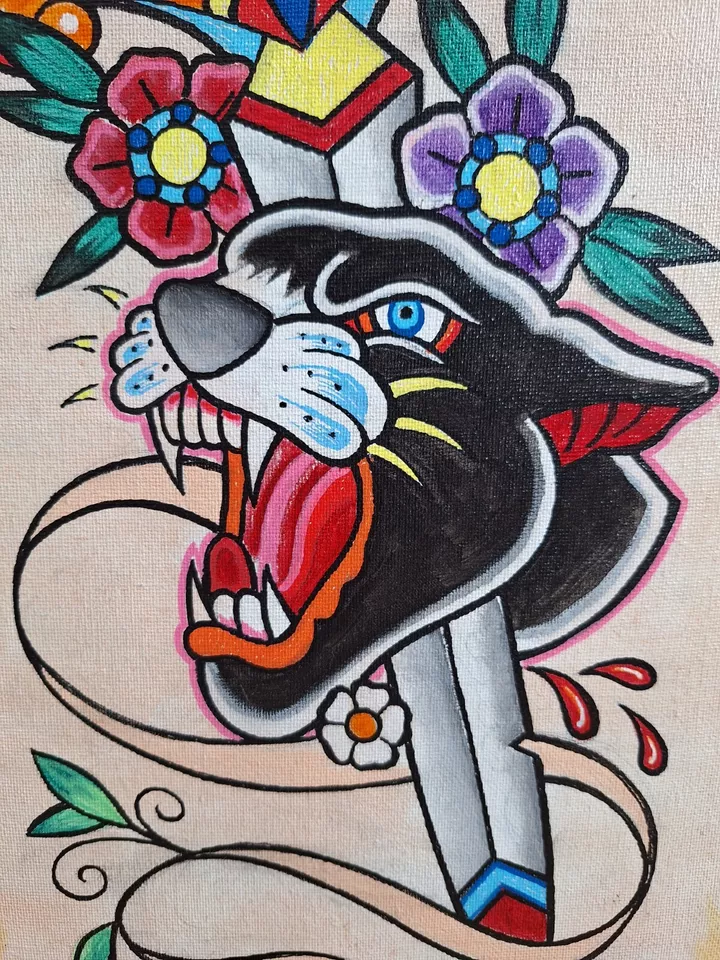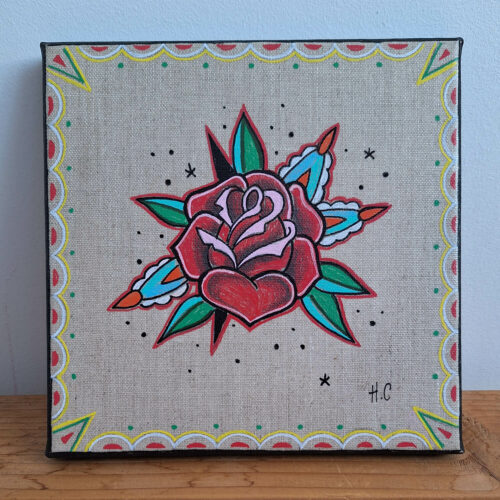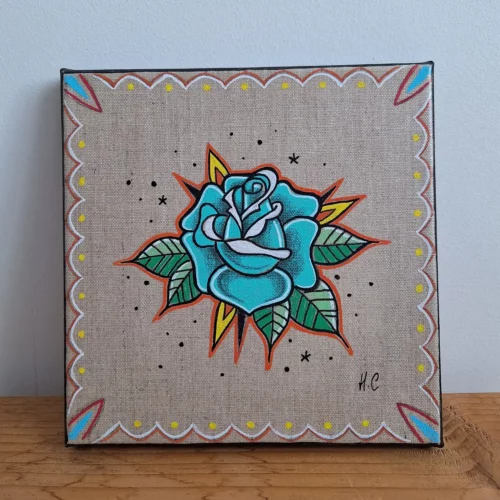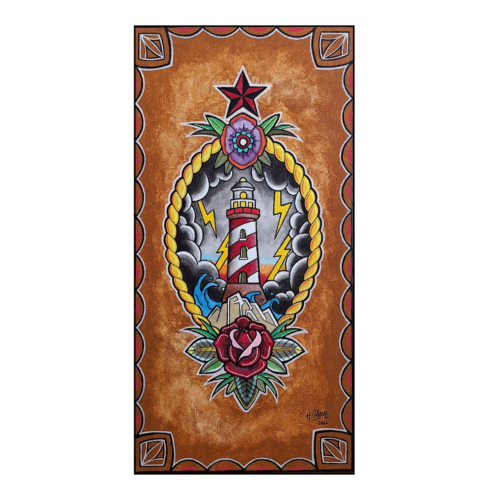Achetez le tableau qui a du caractère !
Rooted in the tradition of American tattooing, the Old School style is a true ode to nostalgia. It draws its origins from the 1920s and 1930s, an era marked by the emergence of Old School tattoo parlors and the rise of a unique aesthetic.
Cultural Origins of Old School Painting
Old School tattoos are deeply tied to maritime culture, sailors, and bikers. The motifs were often chosen for their symbolism:
- The Anchor: A symbol of hope and stability, reminding one of ties to family and home.
- The Heart: Representing love, passion, and loyalty.
- The Rose: A symbol of beauty, femininity, and the fleeting nature of life.
- The Skull: A reminder of mortality and inner strength.
- The Eagle: A symbol of freedom, courage, and power.
These motifs, often paired with pin-up girls, mermaids, or wild animals, quickly transcended the realm of tattooing and established themselves in the art world, particularly in painting.
Characteristics of Old School Painting
Old School painting stands out due to several remarkable features that give it a distinct identity.
First, its vivid and contrasting colors, including reds, blues, greens, and yellows, create dazzling and dynamic compositions. These vibrant tones immediately capture attention and exude a sense of energy.
Second, thick black lines outline the motifs, instilling a sense of strength and character. This bold use of lines enhances the visual impact of the artwork and provides a solid structure.
The motifs themselves are often simple and iconic, allowing each element to stand out at first glance. This simplicity carries deep symbolism, inviting reflection and interpretation. The graphic style features clean shapes with shadows often suggested through delicate hatching, adding depth and interplay with light.
Lastly, the retro atmosphere emanating from Old School creations evokes a bygone era, full of charm and gentle nostalgia. These works serve as windows to the past, rekindling memories and emotions from another time.
In essence, Old School painting is defined by a harmonious combination of colors, lines, motifs, and a nostalgic ambiance, creating a captivating and memorable visual universe.
Why Is This Style Still Popular?
The Old School style appeals due to its universality and timelessness. It evokes a strong world steeped in traditional values and an enduring aesthetic. Furthermore, the simplicity of the motifs and the limited color palette make it an accessible style for all. Old School painting is more than just a trend; it’s a cultural legacy that continues to fascinate with its authenticity and unique character.
Masters of Old School Painting: A Dive into Tattoo History
The Old School style, born in American tattoo parlors in the early 20th century, gradually conquered the art world. Its iconic motifs, vibrant colors, and timeless aesthetic make it a perpetually appreciated style. But which artists left their mark on this discipline?
While it’s challenging to talk about the « greatest artists » in such a subjective field as art, some names stand out for their influence and originality.
Pioneers of Old School Tattooing
The earliest tattoo artists were the craftsmen of this style. They created simple and effective motifs, often inspired by maritime culture, pin-ups, and popular culture. Though mostly anonymous, their work laid the foundation for Old School.
Artists Who Transcended Tattooing
Some tattoo artists managed to bring their art out of tattoo parlors and have it recognized as a legitimate form of artistic expression. Among them are:
Sailor Jerry – The Father of American Old School Tattoos
Considered one of the founding fathers of American tattooing, Sailor Jerry created a unique style characterized by thick lines, vibrant colors, and maritime motifs.
Norman Keith Collins, better known as Sailor Jerry, revolutionized the art of tattooing. Born in 1911, he spent much of his life traveling, tattooing sailors, and encountering diverse cultures, particularly in Japan, which strongly influenced his style.
What made Sailor Jerry legendary was his unique approach:
- He developed a distinct style recognizable for its bold lines, vibrant colors, and motifs often inspired by the sea, pin-up girls, and Hawaiian culture.
- At a time when hygiene standards in tattoo parlors were subpar, Sailor Jerry pioneered sanitary practices. He developed his own inks and emphasized the importance of sterilizing equipment.
Today, his name remains synonymous with authenticity and quality in tattooing. His influence is also celebrated through Sailor Jerry spiced rum, inspired by his adventurous spirit and personal recipes.
Ed Hardy – From Tattoo Artist to Fashion Icon
Another emblematic figure, Ed Hardy popularized Old School style through collaborations with clothing brands. His works are recognized for their vibrant colors and motifs often inspired by Japanese culture.
Don Ed Hardy, the tattoo artist behind the brand, drew heavily from Japanese art, especially ukiyo-e prints. His designs were intricate, featuring floral patterns, dragons, and animals.
In the 2000s, Ed Hardy became globally famous thanks to a collaboration with designer Christian Audigier, who used Hardy’s artwork for a successful clothing line. These bold, colorful designs became a staple of urban fashion, worn by celebrities and widely featured in the media.
Sailor Jerry vs. Ed Hardy
- Sailor Jerry had a more traditional, maritime style, while Ed Hardy’s designs were more complex and influenced by Japanese art.
- Sailor Jerry is primarily remembered as a pioneer of tattooing, whereas Ed Hardy is more associated with a mainstream fashion brand.
Painters Inspired by Old School Style
Many contemporary painters have drawn inspiration from the Old School tattoo universe to create original works. Their paintings adopt the aesthetic codes of tattooing while adding a personal touch. The Old School art scene is dynamic, with new talents emerging regularly.
How to Recognize an Old School Painting
To identify a work in this enchanting style, look for certain magical elements:
- Bright and vibrant colors, contrasted like a sunrise, exemplifying the energy of the style.
- Thick black lines outlining the motifs with striking clarity.
- Simple and iconic motifs, such as anchors, hearts, roses, skulls, eagles, and pin-up girls, evoking memories of a bygone era.
- A retro atmosphere, exuding nostalgia and transporting viewers to forgotten times.
Old School painting is a rich and diverse style that continues to inspire many artists. If you’re looking for original and colorful artwork, dive into this fascinating universe.




